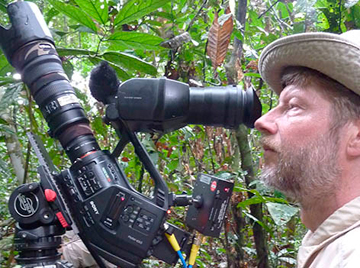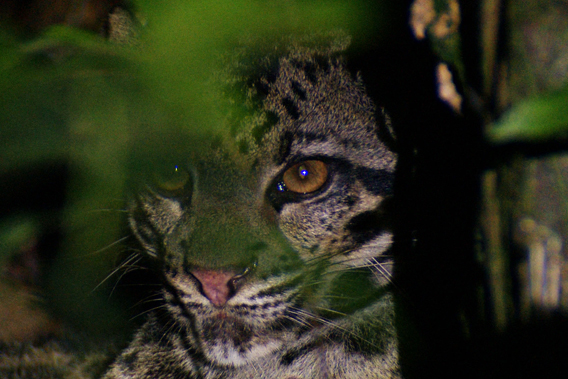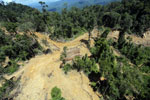
Marbled cat. Photo courtesy of: Jyrki Hokkanen.
In my childhood’s biology books from the 50’s, the Australian marsupial tiger Thylacine is classified rare but alive. Today we know that the last thylacine died in a Tasmanian zoo 7th September, 1936, after a century of intensive hunting encouraged by bounties. The local government had finally introduced official protection 59 days before the last specimen died. Despite the optimism in my old books, no more thylacines were ever found. No film of it in the wild exists.
So, I record wildlife on video. Not as work but as an obligation—and privilege. The thylacine is gone but I have had the opportunity to film a few dozen species from the IUCN Red List of Threatened Species. Several of them are classified Critically Endangered, animals that count on hundred or less pairs in the wild, and declining.
 Jyrki Hokkanen filming in Borneo. Photo by: Jyrki Hokkanen. |
When I was a boy, the industrialized processing of rainforests had only just begun. The conveyor-belt assembly lines already mass-produced newly developed portable aluminum chainsaws for the job. By now, I have witnessed the abolition of half of the Earth’s tropical rainforests.
In Borneo this happened in a couple of decades, after the most intensive forest clearance ever seen. Half of the world’s tropical timber comes from Borneo. Lowland rainforests will soon be all cut in Kalimantan, the Indonesian Borneo. On Malaysian side, somewhat more have been saved for now.
In March 2011 and July 2012 I and my wife Tuija visited two of the best-preserved Malaysian lowland rainforests, Tabin Wildlife Reserve and Danum Valley, to see and film Bornean wildlife as it was.
Rare Cat in Tabin
I don’t make definite plans beforehand what to film. Every walk or drive to a forest is different. Unexpected is the norm. In Tabin 2011 we did several night drives along the edge of an oil palm plantation. Plantations do not support many animals, mainly oil palm fruit eating squirrels, civets, and rats. Their predators like owls and small cats, that are usually hard to see, are drawn there on the open. During my visit in March 2011, I managed to film several leopard cats. The road side grass and shrubs were not in their full Summer height yet so the visibility was excellent.
6:30pm 7th March we were driving back from the main gate towards the Tabin lodge, after filming giant flying squirrels taking off; they glide to their nightly activities from nesting holes at dusk. From the car we saw a cat walking in the grass near the road, on the forest side. We assumed it to be a another leopard cat until got closer and our guide Stephen (Engeri Stephen Etin Sahya) whispered excitedly: “a marbled cat”. Before I got my camcorder ready it had disappeared into grass but soon climbed a roadside tree some meters ahead. It posed there for a couple of minutes, before climbing down and disappearing into bush.
Stephen told us he had last seen a marbled cat a year ago. He is the most experienced guide in Tabin and had spent his whole life in the area, but was still amazed about our luck to observe this rare cat for such a long time. For his request, I made him a personal DVD copy of the video.
Big Cat in Danum Valley
A year later we visited the same locations again, now during the “fig time.” Different fig trees bear fruit at different times and in July the fruiting takes place near the lodges. The trip was again very successful. In three weeks we had observed 20 different orangutan individuals in Tabin and Danum valley. It had been wonderful time, recording hours of mother and baby family life on video.
In the afternoon 2nd August, Danum Valley, we were preparing for our last evening walk before leaving our residence Borneo Rainforest Lodge. Our guide Denny (Dennysius Aloysius) was on a good mood: “today we will go to see the flat headed cat”. Although our walk was to follow a river side, the habitat of this cat, we knew he was joking. Only leopard cats are frequently seen. Other sightings would be very special occasions also to the guides. But what did we know. Denny is one of the few people who has seen all felines of the island, the Bornean Five—leopard cat, marbled cat, bay cat, flat headed cat, and the Sunda clouded leopard. It took him 15 years of full day, and night, guiding.
We took the Segama trail, hiked the south side of Danum River eastward for an hour, then crossed the river and waited for the dark. At twilight, we started walking back the north side towards the Sapa Babandil Stream crossing. After the eardrum piercing six o’clock cicada concert had died down, we turned on our headlights and flashlights and started looking for eye shine. During a night walk several bright-eyed animals are usually seen. We had been in Danum Valley and the nearby Tabin Wildlife Reserve already three weeks and filmed dozens of nocturnal mammals.
6:40pm, less than three kilometers from the lodge, we saw an unusually big pair of eyes about ten meters ahead. Often the animals we spot look down on us from tree level but this was standing amongst ground vegetation. The eyes did not move, also unusual, and a round face was just about visible in the light. It did not behave like a civet, the common medium sized mammal of the night around the trails. The face was not a deer’s face.
I quickly mounted my camcorder on the tripod in the dark, never an easy task. I just got the camera focused and rolling when the eyes moved left and disappeared. By following it with our flashlights we saw a spotty back moving fast through the thick vegetation, down a deep slope, towards the river. We could not keep up and follow. Denny went after it and disappeared from sight also. After a while he came back, shaking his head.
I had got a couple of seconds underexposed footage of it running away. After heavy post processing, the animal would be clearly recognizable on the video. I did not know this yet.

Sunda clouded leopard. Photo courtesy of: Jyrki Hokkanen.
We continued on the trail, sweeping the bushes by our lights, in a dwindling hope to find the animal again. Then 7:05pm Denny noticed eye shine very low, now on the right hand side. This was not what we expected, since the animal had disappeared to the left. I aimed my camera according to Denny’s flashlight, not properly seeing anything yet. Through my viewfinder I saw something with cloudy markings raising up from the undergrowth, where it had been hiding, and looking at us.
There are several spotty, small to medium sized nocturnal mammals in Borneo, like leopard cats and Malay civets for example, but only the marbled cat would have cloudy spots. Besides the Sunda clouded leopard, of course. I could see this was no marbled cat. The head was not of house cat shape, but more robust, and the cloudy markings had spotty substructure. I had identified the cat by elimination but had hard time believing it.
I needed to get at least a few seconds on video. Would it run away again? My hands were shaking—not helpful when filming. Then the clouded leopard clearly relaxed. I could not. I had to follow any sudden movement of my subject. When the cat was not moving, I was busy zooming and re-focusing. Glowing digits, reflecting the state of the camera, floated around the clouded leopard in my viewfinder. I am used to experience wildlife through a scope, like birders. That night, it was a surreal euphoric feeling.
After 15 minutes the clouded leopard was getting tired. Denny had given a great performance in entertaining our guest. The cat had shown keen interest in the moving light, kitten fashion. Now it was time to turn off the lights and quietly leave. The clouded leopard remained on the spot for an hour or more, so also other guests from the lodge had the chance to see this beautiful animal.
Research
When back home from Borneo, I shared my videos with the experts of the field. I have no special expertise on Bornean cats myself so it has been intriguing to learn more about the cats I filmed, and about cat research in general.
Even though researchers still go out on night walks with flashlights, most work is done by remote cameras. Andreas Wilting, of the Leibniz Institute for Zoo and Wildlife Research, has worked with camera traps in lowland forests of Sabah for several years. He explains how to do it:
“We set up a network of about 50 camera-trap stations per 100 square kilometers study area, to collect data on mammal diversity. Each station consists of two digital cameras—protected from elephants in a steel-housing with sharp nails on top—facing each other to ensure that photographs of both flanks of the animal are taken. By this setup most felids and some other species can be distinguished individually on the basis of their distinct coat pattern allowing us to provide precise estimates about the local abundance. But even the greatest number of camera-traps cannot capture all species, for example strictly arboreal animals are very rarely photographed with ground-based camera traps.”
Andrew Hearn, of the Bornean Clouded Leopard Project and Wildlife Conservation Research Unit, Oxford University, has photographed and identified nine different Sunda clouded leopards in Danum Valley with his camera traps. Based on this material he made an effort to identify the individual that I filmed. We have a candidate but positive confirmation would take more detailed camera trap photos.
Andrew also directed my footage to Fernando Najera, who manages a clouded leopard captive breeding center in Thailand. Although the mainland clouded leopard is a different species, parallels can be drawn. According to Fernando, the animal on the video is a young female, perhaps 18 months of age.
Right after the sighting, our guide’s interpretation was that we saw two different young clouded leopards, perhaps waiting for their mother to bring them food. Judging from the few seconds low quality video of the first encounter, the markings on both of these leopards are very similar. So it could have been the same clouded leopard on both occasions. On the other hand, if these were two siblings of the same age, their markings might look alike. Presumably at an age of one year the young become independent from their mother, but as for many other tropical rainforest species, very little is known about the life history of wild Sunda clouded leopards so there are still many things to explore for the researchers on Borneo.
Epilogue
Borneo is still one of the world’s richest ecosystems. The remaining dipterocarp forests are amongst the tallest and oldest in the world. Borneo is the second largest tropical island, surpassed only by the nearby New Guinea. In the height of the dinosaur era, these two used to reside at the extreme ends of one great landmass, the crescent shaped Pangea, making up its two horns. While continental drift brought them close to each other, breaking Pangea up, evolution went separate ways. Over a narrow transitional archipelago, orangutans are now replaced by tree kangaroos, and deer by cassowaries.
So our rare sighting of the Sunda clouded leopard bears a connection back to the forgone years. By filming this elusive top predator of its ecosystem, I recorded the Bornean counterpart of the marsupial tiger from my childhood dreams.
The young female I filmed will have a chance for a good life amongst its kind in the protected Danum Valley. Although rare and classified Vulnerable due to habitat loss, Sunda clouded leopards still count in thousands. For some of the larger mammalian species the future is more bleak.
Like thylacine, also the New Guinean-Australian megafauna died out after the arrival of man. In Borneo the megafauna is still around, but its time is running out. I talked to Dr. John Payne of the Borneo Rhino Alliance BORA about the present situation. “The pygmy elephant population is holding on. The extent of forest cover is stabilizing in Sabah, northeast Borneo, and as a result of repeated logging, there is lots more elephant food in the forests than previously. Being group-living animals, males and females can always find each other at the ‘right’ times and breed. But the solitary Bornean rhinoceros, the world’s smallest and hairiest rhino, is on the very edge of survival. Fewer than 40 of this subspecies of rhino exist in highly fragmented populations. The low probability of fertile females and males meeting in the wild leads to aging without reproducing. BORA helps to ensure that remaining rhinos are secured within protected areas. Within these forested refuges, BORA is working towards greater reproductive success amongst the few remaining rhinos, and the ultimate restoration of the rhino population in Borneo’s rainforests.”
Will Borneo’s magnificent biological diversity last for the future generations to experience? Indonesia, Malaysia, and Brunei, the countries sharing the Borneo island, have recently signed “Heart of Borneo” conservation initiative, to preserve one third of the Bornean rainforests, mainly belonging to the difficult-to-log central highland forests. How this is executed remains to be seen. The history of Bornean conservation includes plenty of protected parks logged down due to local politics and corruption.
Related articles
Indonesian province of East Kalimantan imposes moratorium on deforestation
(02/02/2013) The Indonesian province of East Kalimantan has imposed a one-year moratorium on new permits for logging, mining, and oil palm plantations, reports Reuters.
Palm oil, paper, biofuels production on peatlands drive large GHG emissions
(01/31/2013) Degradation of peat swamps for oil palm and timber plantations is a substantially larger source of greenhouse gas emissions than previously believed, finds a new study published in the journal Nature.
14 Bornean elephants found dead, likely poisoned

(01/31/2013) Wildlife officials in the Malaysian state of Sabah have found the bodies of 14 Bornean elephants in Gunung Rara Forest Reserve, and suspect that more may be found dead. While tests are pending, they believe the elephants were likely poisoned due to damage in the animals’ digestive tracts. Only around 2,000 Bornean elephants (Elephas maximus borneensis) are left on the island of Borneo with the vast bulk found in Sabah.
New palm oil concession imperils orangutan population in Borneo
(01/28/2013) Three conservation groups warn that a proposed palm oil plantation puts a significant Bornean orangutan (Pongo pygmaeus) population at risk in the Malaysian state of Sabah. The plantation, which would cover 400 hectares of private forest land, lies adjacent to Kulamba Wildlife Reserve, home to 480 orangutans.
Helping Borneo’s indigenous people fight for their forests

(01/28/2013) In the 1980’s and 1990’s more timber was removed from the rainforests Borneo than from all of Africa and South America combined. This tragic loss of habitat, with its attendant loss of wildlife and indigenous cultures, has gone largely unrecognized in the United States. Joe Lamb, a Berkeley-based writer, activist, and arborist, has worked to change that.
New species of cute, but venomous, primate discovered in Borneo
(12/13/2012) Researchers have described a new species of slow loris, a type of primate that is imperiled by the pet trade.
Rare jungle cat filmed for only the second time
(12/12/2012) A biologist on vacation in Malaysian Borneo caught one of the world’s rarest cats on video for only the second time, reports the BBC.